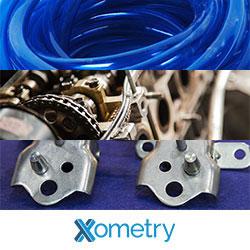Ensuring the Reliability of Electronic Devices Through Non-Destructive Testing of Specialty Metals & Materials
Non-destructive advanced scanning acoustic microscopy detects flaws in specialty metals, materials, and packaging of semiconductor devices
Manufacturers of high-end semiconductor electronic products used in consumer, industrial, and military applications have long relied on precise testing methodologies to identify the location of defects such as voids, cracks, and the delamination of different layers within a microelectronic device, also known as a Chip. Manufacturers employ a range of other techniques: scanning acoustic microscopy (SAM), a non-invasive and non-destructive ultrasonic testing method, has become an industry standard to detect and analyze flaws during various chip production steps and in the final quality inspection after packaging.
In addition, SAM is often utilized as a Failure Analysis method when needed to identify a specific root cause failure mechanism when a device fails during use.
Beyond semiconductor components themselves, today's electronics products contain various specialty metals, alloys, plastics, and glass components. All semiconductor components need to be enclosed and packaged in consumer usable formfactors. As a result, SAM equipment has evolved and is now being used to detect subsurface flaws, dis-bonds, cracks, and other irregularities in these types of materials that constitute "packaging" of semiconductor components.
With the same rigor of failure analysis and quality testing used for semiconductors now being applied to metals and alloys, both the production yield and overall reliability of electronic devices have improved significantly. In doing so, projects are completed in less time while eliminating potential points of failure in the field.
"The reality is that a failure in an electronic product package or a non-semiconductor component can be just as catastrophic as a failure with the semiconductor," said Hari Polu, President of OKOS, a Virginia-based manufacturer of SAM and industrial ultrasonic non-destructive (NDT) systems. The company serves the electronics manufacturing, aerospace, and metal/alloy/composite manufacturers, and end-user markets.
Detecting Flaws with SAM
SAM is a powerful non-invasive and non-destructive method for inspecting internal structures in optically opaque materials. Depth-specific information can be extracted and applied to create two- and three-dimensional images without the need for time-consuming tomographic scan procedures and more costly X-rays.
SAM works by directing focused ultrahigh frequency sound from a transducer at a tiny point on a target object. The sound as it passes through the material is either scattered, absorbed, reflected, or transmitted. Detection of the direction of scattered pulses and measuring the TOF "time of flight," the presence of a boundary or object is determined and its distance. Three-dimensional images are created by scanning point by point and line by line on an object. Scan data is digitally captured and processed by special imaging software and filters to resolve a specific area of focus in either single or multiple layers.
According to Polu, the industrial sector has traditionally utilized other methods considered inferior compared to what is being used in today's semiconductor industry. However, with SAM equipment, specialty materials manufacturers can achieve the same level of failure testing to the companies that make metals, alloys, composites, and titanium plates used in electronic devices.
"OKOS has leveraged the lessons and the tight specifications from the semiconductor world and adapted our SAM scanning systems for various form factors and provide unique solutions for specialty crystalline, metals, and other material for our customers in the industrial markets," said Polu. "With this type of testing, we can inspect materials at a level one to two orders of magnitude better to discover flaws that were previously undetected."
Today, much of the SAM equipment can inspect various items with unique product geometries or sizes, from crystal ingots, wafers, and electronics packages to miniature physical packaging, metal bar/rods/billets, turbine blades, etc. However, as important as the physical and mechanical aspects of conducting a scan, the software is the key to analyzing the information to produce detailed scans.
For this reason, "OKOS decided early on to deliver a software-driven, ecosystem-based solution," said Polu. The company's ODIS Acoustic Microscopy software supports a wide range of transducer frequencies from 2.25 to 230 MHz.
Multi-axis scan options enable A, B, and C-scans, contour following, off-line analysis, and virtual rescanning for composites, metals, and alloys, which result in highly accurate internal and external inspection for defects and thickness measurement via the inspection software.
Polu estimates that their software-driven model enables them to drive down the costs of SAM testing while delivering the same quality of inspection results. As a result, this type of equipment is well within reach of even modest testing labs, R&D centers, and material research groups.
"Every company will eventually move towards this level of failure analysis because of the level of detection and precision required for specialty metals and materials," says Polu. "The cost advantages and time savings of Industrial SAM equipment make this possible."
SAM systems have an integral role in semiconductor device manufacturing based on their precision, usability, and time-saving advantages compared to other NDT options. Extending this testing methodology beyond semiconductor components to specialty metals and materials throughout a semiconductor device can provide more robust failure detection capability for manufacturers of consumer, industrial and military electronic devices.
For more information, contact OKOS at info@okos.com or visit www.okos.com.
OKOS is a Division of PVA TePla AG, Germany.
Featured Product

